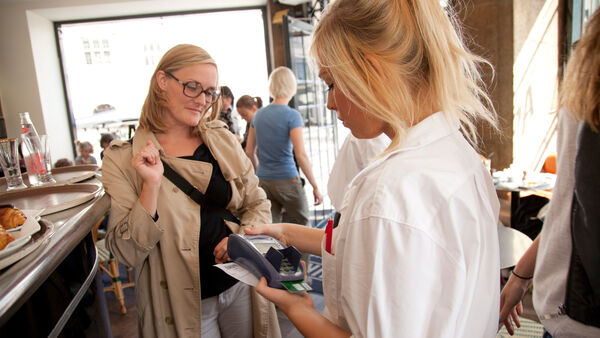Will My Credit Card Work in Europe?
By Rick Steves
Despite some differences between European and US cards, there's little to worry about. US-issued Visa and Mastercard credit cards, along with familiar payment apps, typically work fine in Europe.
Ways to Pay
Tap your card (a.k.a. contactless payment): If your card has the tap-to-pay symbol (four curved lines, like a Wi-Fi symbol on its side), you can pay by simply tapping it against a contactless reader — no PIN or signature required. This is by far the easiest way to pay and is available in much of Europe. In London, for example, some small businesses (such as market stalls andfood stands) accept only tap cards, and sometimes don't accept cash.
Tap your phone/watch: Just like at home, you can pay with your phone or smartwatch if it's linked to a credit card via an app such as Apple Pay or Google Pay. To pay, hold your phone near a contactless reader; you may need to verify the transaction with a face or fingerprint scan, or a passcode. If you've arrived in Europe without a tap-to-pay card, you can easily set up your phone to work in this way. (Doing this does not require an internet connection — you don't need to be on Wi-Fi and you won't be charged for data usage.)
Insert your card in chip reader: If your card has a visible chip embedded in it (most likely it does), pay by inserting the card, chip first, into the payment machine, then entering your PIN on a keypad.
Swipe your card: Machines that can read a card's magnetic stripe (and then print a receipt for you to sign) are being phased out in Europe faster than in the US. If your card only has a magnetic stripe (no chip, no contactless symbol), it's worth requesting a new card before your trip. (Failing that, connect that card to a payment app.)
Will My US Card Work?
Usually, yes. On rare occasions, you may run into a situation where your card doesn't work. This is most likely to happen at self-service payment machines (such as transit-ticket kiosks, tollbooths, or fuel pumps), especially if you don't have a tap-to-pay card or mobile device. If you run into trouble, look for a cashier who can process your payment manually. (You might want to allow a little extra time at train stations and the like, as staffed service windows almost always have longer lines than ticket machines.) If your card still doesn't work, you'll likely need to contact your bank to remove a hold.
Of course, you can almost always pay in cash — keep enough on you, as backup, to cover your day's key purchases. Some payment machines take only coins, so it's smart to keep spare change handy (especially for highway toll booths, parking garages, luggage lockers, bike-rental kiosks, etc.).
Drivers need to be prepared for possible card hassles at fuel pumps, and prepared to move on to the next gas station if necessary — don't let your tank get too low, especially if driving at night or on Sundays, when stations are unlikely to be staffed. When approaching a toll plaza or ferry ticket line, use the easier (if slower) "cash" lane to avoid potential card problems.
Dynamic Currency Conversion: Just Say No
Many European merchants and hoteliers — capitalizing on the fact that some Americans are intimidated by unusual currencies — cheerfully charge you for converting your purchase price into dollars. If it's offered, refuse this "service" (called dynamic currency conversion, or DCC).
On many card machines, that means pressing an up or down arrow to navigate from a default of "USD" as the currency charged to "EUR" (or whatever the local currency is). If you're handed a receipt with two totals — one in the local currency and the other in US dollars — circle the amount in the local currency before you sign.
Otherwise you'll pay a high price for the "convenience" of seeing your charge in dollars. The price is usually extracted by converting the charge at a lousy exchange rate set by the merchant's bank — and even though you're paying in "dollars," your credit-card issuer may still levy its standard foreign-transaction fee.
DCC charges are common all over Europe; in some countries major banks require merchants to offer it. According to Visa and Mastercard, consumers have the right to decline DCC service: If your receipt shows the total in dollars only, ask that it be rung up again in the local currency. If the merchant refuses to run the charge again, pay in cash, or mark the receipt "local currency not offered" and warn the clerk that you will be disputing the charges with your bank.
Some ATM machines also try to trick users into DCC by using purposefully confusing or misleading wording. If an ATM offers to "lock in" or "guarantee" your conversion rate, choose "continue without conversion." Other prompts might state, "You can be charged in dollars: Press YES for dollars, NO for euros." Always choose the local currency.


